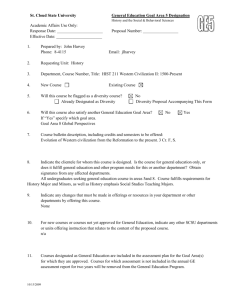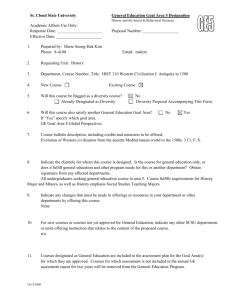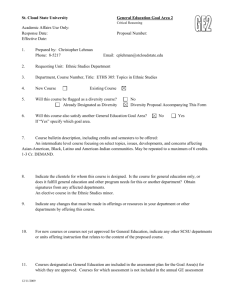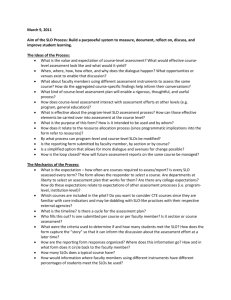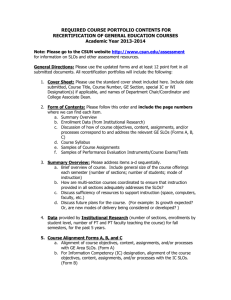GE-10-6. HIST 105 Studies in U.S. History
advertisement
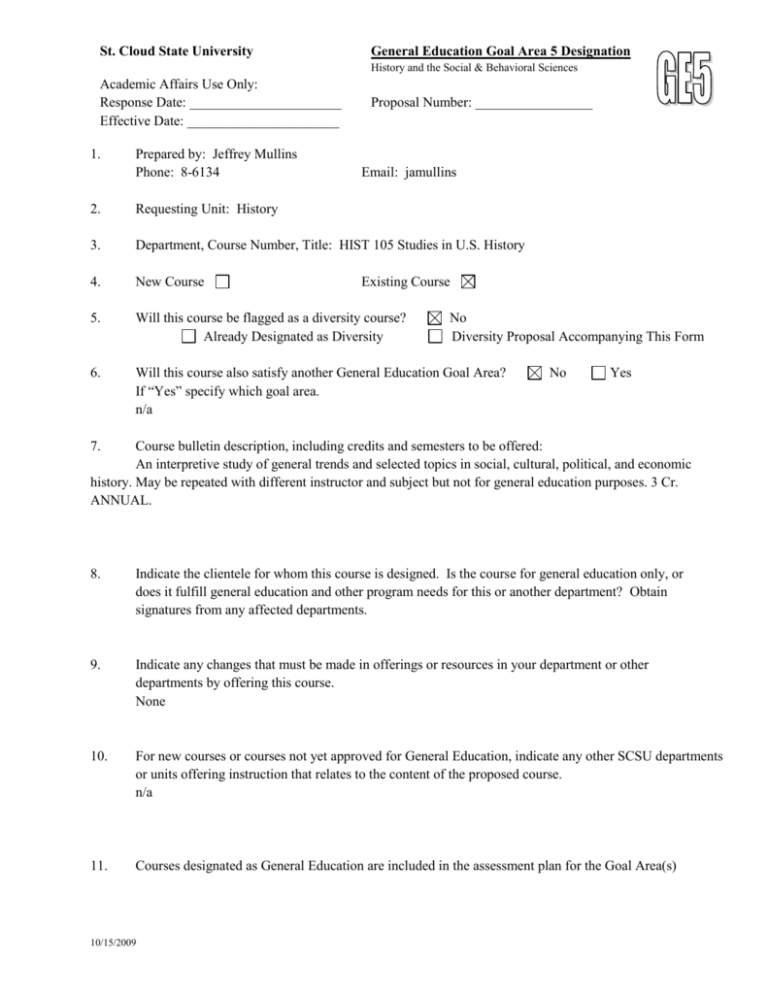
St. Cloud State University General Education Goal Area 5 Designation History and the Social & Behavioral Sciences Academic Affairs Use Only: Response Date: ______________________ Effective Date: ______________________ 1. Prepared by: Jeffrey Mullins Phone: 8-6134 Proposal Number: _________________ Email: jamullins 2. Requesting Unit: History 3. Department, Course Number, Title: HIST 105 Studies in U.S. History 4. New Course 5. Will this course be flagged as a diversity course? Already Designated as Diversity 6. Will this course also satisfy another General Education Goal Area? If “Yes” specify which goal area. n/a Existing Course No Diversity Proposal Accompanying This Form No Yes 7. Course bulletin description, including credits and semesters to be offered: An interpretive study of general trends and selected topics in social, cultural, political, and economic history. May be repeated with different instructor and subject but not for general education purposes. 3 Cr. ANNUAL. 8. Indicate the clientele for whom this course is designed. Is the course for general education only, or does it fulfill general education and other program needs for this or another department? Obtain signatures from any affected departments. 9. Indicate any changes that must be made in offerings or resources in your department or other departments by offering this course. None 10. For new courses or courses not yet approved for General Education, indicate any other SCSU departments or units offering instruction that relates to the content of the proposed course. n/a 11. Courses designated as General Education are included in the assessment plan for the Goal Area(s) 10/15/2009 for which they are approved. Courses for which assessment is not included in the annual GE assessment report for two years will be removed from the General Education Program. The Requesting Unit understands and recognizes the above conditions. 12. Provide a concise explanation of how the following goal is a “significant focus” of the proposed course. Goal Area 5: History and the Social & Behavioral Sciences Develop understanding of human societies and behaviors, and of the concepts, theories, and methods of history and the social sciences. Through the “Studies in U.S. History” students will acquire a familiarity with major events and figures as studied via different human societies and behaviors. The student will also develop skills in critical reading of both primary and secondary sources, in research, in the comprehension of textual and lecture material, in class discussion, and in the composition of essays. 13. In order for a course to be designated as fulfilling Goal Area 5, it must address at least 4 of the 5 student learning outcomes (SLOs) below. Check the SLOs below that are focused on in the proposed general education course. 1. Describe or use the methods and data by which historians, social scientists, or behavioral scientists investigate human conditions. 2. Analyze human behavior, cultures, and social institutions and processes from the perspectives of history or the social and behavioral sciences. 3. Develop explanations for and explore solutions to historical or contemporary social problems. 4. Reflect upon themselves in relation to family, communities, society, culture, and/or their histories. 5. Apply and critique alternative explanatory systems or theories about human societies and behaviors. 14. Discuss how each Student Learning Outcome checked above is achieved in this course. (Note: Although descriptions of typical assignments or types of assignments may be part of this discussion, it is not appropriate to submit copies of actual assignments.) 1. As fundamental courses in history, these versions of HIST 105 have a pervasive engagement with SLO 1, exploring both historical methods and data. 2. Each version of HIST 105 is focused on human behavior, cultures, and social institutions & processes as seen from the perspective of history, and so meet SLO 2. 3. Through a series of regular writing assignments, students develop explanations for, and explore solutions to, historical social problems, thereby fulfilling SLO 3. 4. Both the readings and writing assignments require students to reflect upon the history of communities, society and culture, providing the means to embody SLO 4. 5. By presenting and scrutinizing a variety of historiographical approaches to the material, HIST 105 meets the aim of SLO 5 to apply and critique a variety of explanatory systems of human societies and behaviors. 10/15/2009 15. List or attach the Course Outline (adequately described and including percentage of time to be allocated to each topic). Curriculum Committees may request additional information. Topics larger than 20% need to be broken down further. Indicate in your course outline where the Student Learning Outcomes checked above are being met. The Student Learning Outcomes are met throughout the curriculum described in the course outlines below: 1. Course Outline: A view of American history that highlights the pervasive early American dialogue on “selfgovernment,” examining its manifestations in efforts at social reform, and placing it in the context of dynamics. I. Early modern discussion of human nature and the possibility of self-government (10%) II. Colonial racial dynamics (10%) III. Revolutionary reliance on concepts of self-government, and their implicit promise of universal equality (10%) IV. Social reform movements of the early republic as a means to instill drive for self-government in the fabric of American society (15%) V. Shifting concepts of race involved in emergent “racial modernism” (15%) VI. Shifting concepts of human nature, and their implications for understandings of self-government (15%) VII. Fundamental clash of reform drive with emergent racial ideology (15%) VIII. Long-term ramifications of the above developments (10%) 2. Course outline: A view of American history from the perspective of Americas whose race, sex, religion, and ethnic derivation have set them apart from the mainstream of American life. I. NATIVE AMERICANS (20%) A. Origins, Customs and Beliefs, “Indian-ness” B. Stereotyped Indian: Indian-white relations and Indian policy; Indian Contributions to American Life. C. Native Americans Today—Poverty, Protest. II. AFRO-AMERICANS (30%--broken down below) A. African Origins and the Slave Trade (5%) B. Blacks in ante-bellum America (5%) 1. Slavery and the Slave 2. Not Quite Free: Blacks in the North C. False Dawn: Civil War + Reconstruction (5%) D. Continuing Patterns of Prejudice: Impact of Segregation, Discrimination (10%) E. Twentieth Century Black Protest (5%) III. IMMIGRATION, 1830-1920s (25%--broken down below) A. The Irish and Anti-Catholicism (10%) B. New Immigration (post 1880s) – Italians, Jews, Poles, etc., Customs and Adjustment to American Life (10%) C. Stereotyping the Immigrant; Xenophobia, Racism, the WASP Syndrome, the KKK. (5%) IV. AMERICAN WOMEN (25%--broken down below) A. Women’s “Natural Inferiority” – Social, Physical, Religious “Proofs.” (10%) B. “Women’s Place”—Legal, Economic, Social Discrimination. (5%) C. Protest—From Women’s Rights to Women’s Lib.(10%) 3. Course outline: A view of American history from the perspective of individual ethnic and family background. Includes the history of various ethnic groups in the United States. 10/15/2009 I. INTRODUCTION – Ethnicity in American History (10%) II. THE STRUCTURE OF ETHNIC SOCIETY: The Family, The Church, The School; Social, Cultural and National Associations (20%) III. THE ETHNIC EXPERIENCE, 1607-1820: Anglo-Prostestant, Scotch-Irish, Germans, the Africans. (20%) IV. THE NORDIC AND GAELIC IMMIGRANTS, 1820s-1920s (15%) A. Areas, Causes, and Means of Immigration B. Settlement, Family, and Social Patterns C. The American Response V. THE SOUTH AND EAST EUROPEANS, 1890s-1920s (20%) A. Groups, Areas, Causes of Immigration B. Patterns of Settlement and Family—Social Structures. C. The American Response VI. IMMIGRATION SINCE RESRICTIONS (15%) A. Laws B. Refugees C. Inter-American Migration D. Rural-Urban Migration 10/15/2009
